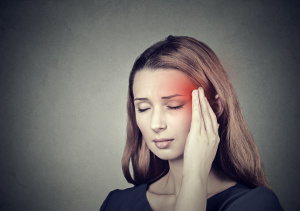Higher omega-3 intake helps against migraine
 Migraine is a common neurological disease that reduces quality of life and results in many sick days. Migraine medication does not work for everyone and many people have adverse effects, so it makes more sense to focus on prevention. A new American study shows that diets with higher levels of omega-3 fatty acids from oily fish can reduce the frequency of migraines compared with eating an average diet. People who dislike the taste of fish can take a high-quality fish oil supplement, instead.
Migraine is a common neurological disease that reduces quality of life and results in many sick days. Migraine medication does not work for everyone and many people have adverse effects, so it makes more sense to focus on prevention. A new American study shows that diets with higher levels of omega-3 fatty acids from oily fish can reduce the frequency of migraines compared with eating an average diet. People who dislike the taste of fish can take a high-quality fish oil supplement, instead.
Migraine is a chronic neurological disorder that affects around 15 percent of the world’s population. It usually occurs as a one-sided, overpowering headache and is often accompanied by nausea and sensitivity to light and noise. An attack normally lasts anywhere from four to 72 hours, and it is among the conditions with the highest number of sick days.
It is believed that the pain is provoked by a sudden dilation of the large and sensitive blood vessels in the cerebral cortex (the exterior part of the brain.) What causes the migraine to start and stop, however, is altered electric activity in the brain neurons. Local neuroinflammation may also play a role.
The study reveals that higher omega-3 intake is as effective as migraine medicine
A total of 182 migraine patients took part in the study. They were randomly assigned to three different groups. The patients had migraines 5-20 days every month, and the duration of the study was 16 weeks. There were two treatment groups. Participants in both treatment groups had their daily intake of the omega-3 fatty acids, EPA and DHA, increased by 1.5 grams. EPA and DHA are found in oily fish. In addition, one of the treatment groups got the same (high) quantity of omega-6 fatty acids as the control group, while the other treatment group got a reduced amount of omega-6. We primarily get omega-6 from plant oils, margarine, and industrially processed food. The control group consumed the normal amount of omega-3 fatty acids, which is less than 150 mg of EPA and DHA daily, and the normal amount of omega-6.
The dietary changes were made by adjusting the dietary content of plant oils, butter, and protein-rich sources such as fish. The headache frequency was reduced in both treatment groups where the omega-3 intake was increased by 1.5 grams per day. In the one treatment group where the omega-3 intake was raised without adjusting the omega-6 intake, participants experienced two fewer headache days on average compared with the control group. In the other treatment group where the omega-3 intake was increased and the omega-6 intake was decreased, participants had four fewer headaches on average.
The volunteers in both treatment groups reported having shorter and less severe headache attacks than the control group. The scientists behind the new study refer to other recent studies where the use of migraine medicine has been seen to lower the number of headache dayd by 2 to 2.5 days a month. They say that an increase in omega-3 consumption could potentially be every bit as effective, or perhaps even better, than the use of synthetic drugs. If you lower the intake of omega-6 at the same time, the effect is even better. The new study is published in British Medical Journal (BMJ).
The vital balance between omega-3 and omega-6
Omega-3 and omega-6 are essential fatty acids that we must get from our diet. They occur naturally in different forms. In our cells, we have the two types of omega-3 known as EPA and DHA plus AA (arachidonic acid), a type of omega-6. These fatty acids are involved in a host of different physiological functions that are important for cell signaling, gene activation, and the production of different types of prostaglandins that initiate and terminate inflammatory processes.
It is essential to have the proper balance between omega-3 and omega-6. If we get too little omega-3 or too much omega-6, it sets the stage for inflammation and other imbalances that appear to be able to trigger a migraine attack.
Oily fish and fish oil supplements
The additional 1.5 grams of EPA and DHA daily in this study is an amount that is easily obtained by eating some herring. If you don’t like the taste of fish or simply don’t get fish all that often, a fish oil supplement can easily be used as alternative or as an add-on to your diet. Fish oil based on free fatty acids are easier for the body to absorb and utilize. You should also check the peroxide value and any traces of environmental toxins to make sure that they are within the levels accepted by health authorities.
| Content g/100 gram | EPA | DHA |
| Cod liver | 6.5 | 4.8 |
| Smoked mackerel | 1.6 | 1.4 |
| Salted herring | 1.4 | 1.9 |
| Marinated anchovies | 0.9 | 1.1 |
| Salmon (free range) | 0.8 | 1.9 |
| Smoked herring | 0.8 | 1.3 |
| Mackerel in tomato | 0.6 | 1.1 |
| Farmed salmon | 0.4 | 0.6 |
| Cod roe (raw) | 0.2 | 0.4 |
| Boiled shrimp | 0.2 | 0.2 |
References:
Burch R. Dietary omega 3 fatty acids for migraine. BMJ 2021
Lars Edvinsson et al. Does inflammation have a role in migraine? Nature Reviews Neurology 2019
Frida - Parametre (fooddata.dk)
Search for more information...
- Created on .








